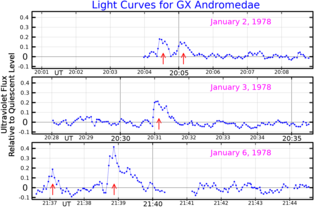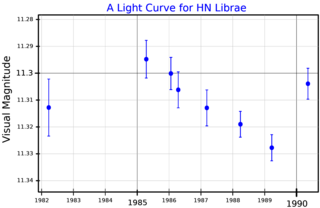HD 93083 is an orange-hued star in the southern constellation of Antlia. It has the proper name Macondo, after the mythical village of the novel One Hundred Years of Solitude. The name was selected by Colombia during the IAU's NameExoWorlds campaign. The star has an apparent visual magnitude of 8.30, which is too faint to be visible to the naked eye. It is located at a distance of 93 light years from the Sun based on parallax. HD 93083 is drifting further away with a radial velocity of +43.65 km/s, having come to within 43 light-years some 484,000 years ago.

Groombridge 34 is a binary star system in the northern constellation of Andromeda. It was listed as entry number 34 in A Catalogue of Circumpolar Stars, published posthumously in 1838 by British astronomer Stephen Groombridge. Based upon parallax measurements taken by the Gaia spacecraft, the system is located about 11.6 light-years from the Sun. This positions the pair among the nearest stars to the Solar System.
Gliese 674(GJ 674) is a small red dwarf star with an exoplanetary companion in the southern constellation of Ara. It is too faint to be visible to the naked eye, having an apparent visual magnitude of 9.38 and an absolute magnitude of 11.09. The system is located at a distance of 14.85 light-years from the Sun based on parallax measurements, but is drifting closer with a radial velocity of −2.9 km/s. It is a candidate member of the 200 million year old Castor stream of co-moving stars.
Gliese 849, or GJ 849, is a small, solitary star in the equatorial constellation of Aquarius. It has a reddish hue and is invisible to the naked eye with an apparent visual magnitude of 10.41. The distance to this star is 28.8 light-years based on parallax, but it is drifting closer to the Sun with a radial velocity of −15.3 km/s. It has a pair of confirmed gas giant companions.
Gliese 412 is a pair of stars that share a common proper motion through space and are thought to form a binary star system. The pair have an angular separation of 31.4″ at a position angle of 126.1°. They are located 15.8 light-years distant from the Sun in the constellation Ursa Major. Both components are relatively dim red dwarf stars.
Gliese 317 is a small red dwarf star with two exoplanetary companions in the southern constellation of Pyxis. It is located at a distance of 49.6 light-years from the Sun based on parallax measurements, and is drifting further away with a radial velocity of +87.8 km/s. This star is too faint to be viewed with the naked eye, having an apparent visual magnitude of 11.98 and an absolute magnitude of 11.06.
Gliese 176 is a small star with an orbiting exoplanet in the constellation of Taurus. With an apparent visual magnitude of 9.95, it is too faint to be visible to the naked eye. It is located at a distance of 30.9 light years based on parallax measurements, and is drifting further away with a heliocentric radial velocity of 26.4 km/s.
Gliese 682 or GJ 682 is a red dwarf. It is listed as the 53rd-nearest known star system to the Sun, being 16.3 light years away from the Earth. Even though it is close by, it is dim with a magnitude of 10.95 and thus requires a telescope to be seen. It is located in the constellation of Scorpius, near the bright star Theta Scorpii. The star is in a crowded region of sky near the Galactic Center, and so appears to be near a number of deep-sky objects from the Solar System's perspective. The star is only 0.5 degrees from the much more distant globular cluster NGC 6388.
Gliese 433 is a dim red dwarf star with multiple exoplanetary companions, located in the equatorial constellation of Hydra. The system is located at a distance of 29.6 light-years from the Sun based on parallax measurements, and it is receding with a radial velocity of +18 km/s. Based on its motion through space, this is an old disk star. It is too faint to be viewed with the naked eye, having an apparent visual magnitude of 9.81 and an absolute magnitude of 10.07.
Gliese 179 is a small red dwarf star with an exoplanetary companion in the equatorial constellation of Orion. It is much too faint to be visible to the naked eye with an apparent visual magnitude of 11.94. The system is located at a distance of 40.5 light-years from the Sun based on parallax measurements, but is drifting closer with a radial velocity of –9 km/s. It is a high proper motion star, traversing the celestial sphere at an angular rate of 0.370″·yr−1.
Gliese 251, also known as HIP 33226 or HD 265866, is a star located 18.2 light-years away from the Solar System. Located in the constellation of Gemini, it is the nearest star in this constellation. It is located near the boundary with Auriga, 49 arcminutes away from the bright star Theta Geminorum; due to its apparent magnitude of +9.89 it cannot be observed with the naked eye. The closest star to Gliese 251 is QY Aurigae, which is located 3.5 light years away.
Gliese 15 Ab, also called Groombridge 34 Ab, rarely called GX Andromedae b is an extrasolar planet approximately 11 light-years away in the constellation of Andromeda. It is found in the night sky orbiting the star Gliese 15 A, which is at right ascension 00h 18m 22.89s and declination +44° 01′ 22.6″.

HN Librae, also known as Gliese 555, is a small star with one or more orbiting exoplanets in the constellation Libra. With an apparent visual magnitude of 11.32, it can only be viewed through a telescope. The system is located at a distance of 20.4 light years based on parallax measurements, but is drifting closer to the Sun with a radial velocity of −1.4 km/s. It does not appear to belong to any known stellar moving group or association.
Gliese 880 is a red dwarf star 22.4 light-years away in the northern constellation of Pegasus. No stellar companions to Gliese 880 have been discovered as of 2020.

GJ 1151 is a star located in the northern circumpolar constellation of Ursa Major at a distance of 26.2 light-years from the Sun. It has a reddish hue and is too faint to be visible to the naked eye with an apparent visual magnitude of 14.0 The star is moving closer with a radial velocity of −36 km/s, and has a relatively large proper motion, traversing the celestial sphere at a rate of 1.815″·yr−1.
GJ 3512 is a nearby star in the northern circumpolar constellation of Ursa Major. It is invisible to the naked eye but can be observed using a telescope, having an apparent visual magnitude of +15.05. The star is located at a distance of 31 light-years from the Sun based on parallax. It has a high proper motion, traversing the celestial sphere at the rate of 1.311″ yr−1. The measurement of the star's radial velocity is poorly constrained, but it appears to be drifting further away at a rate of ~8 km/s.
Gliese 536 b also known as GJ 536 b is a nearby Super-Earth sized exoplanet orbiting interior to the circumstellar habitable zone of the red dwarf (M1) star Gliese 536 every 8.7 days. Due to its short orbital period it could help with future studies of biological activity on exoplanets.

Teegarden's Star b is an exoplanet found orbiting within the habitable zone of Teegarden's Star, an M-type red dwarf 12.5 light years away from the Solar System. It had the highest Earth Similarity Index (ESI) of any exoplanet, but in February 2024 a new study updated the parameters of the planet, thus reducing its ESI to 0.90, making it no longer the planet with the hightest ESI. Along with Teegarden's Star c, it is among the closest known potentially habitable exoplanets.




